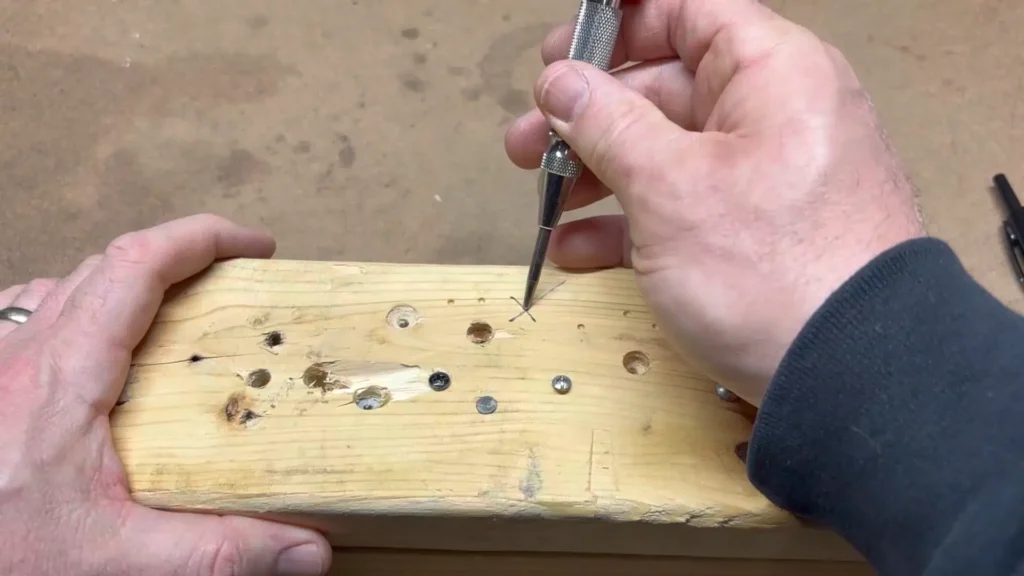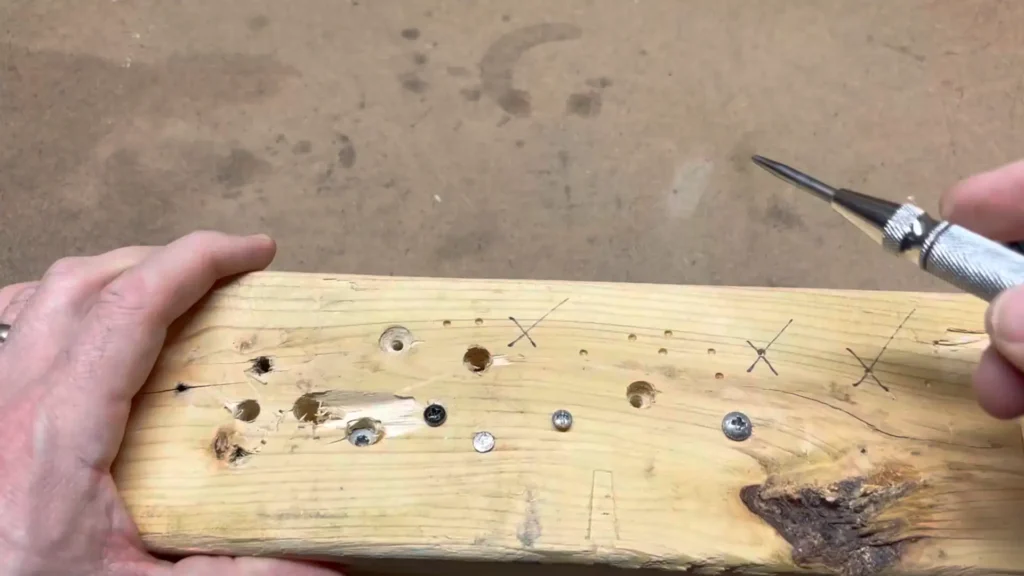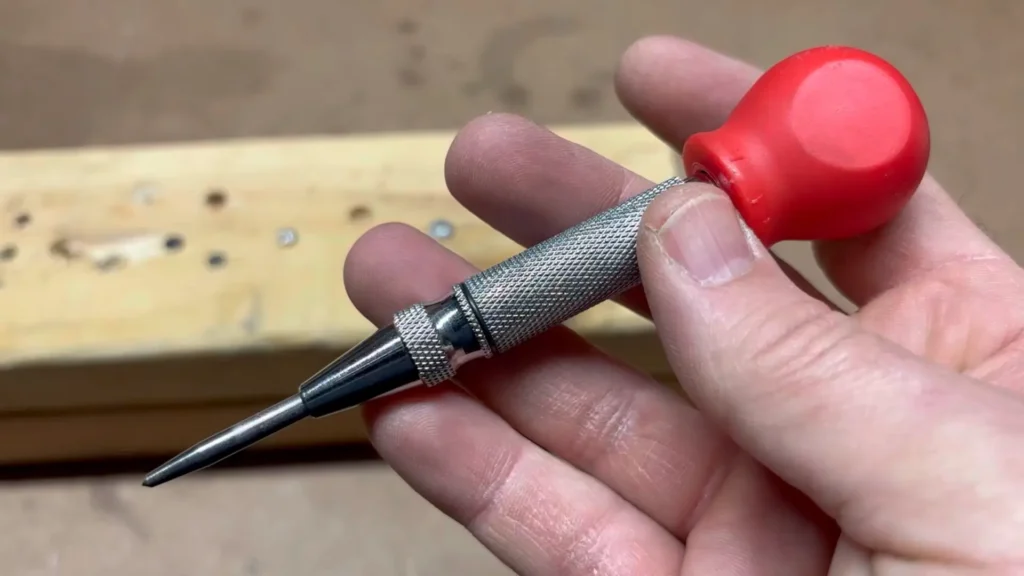Quick Summary: NEIKO 02638A Center Punch Review: Experts in Metalwork Prefer
- Content Type: Hand Tested Review
- Affiliate Link Present: Yes
A center punch might look basic, but it plays a key role in accurate metalworking by helping create clean precise drill marks. When I began working with metal, I soon realized how crucial an automatic center punch is. This tool makes consistent dimples on materials, which help in positioning drills with accuracy.
Not all center punches perform the same. A spring-loaded center punch tool needs at least 25 pounds of force to leave a stamped mark and can deliver up to 225 pounds to create deeper impressions. This level of force plays a key role since center punches help mark precise drilling spots on thin materials like aluminum sheets. Using these tools does take practice. You have to keep the auto center punch upright when activating the punching action. The NEIKO 02638A shines as a flexible 5-inch automatic center punch that can be used on materials such as wood, plastic, metal, glass, and leather.
In this detailed review, I’ll talk about using the NEIKO 02638A center punch, look at how it’s built, try it out on various materials, and help you figure out if it’s worth adding to your toolbox.
Disclaimer
Affiliate Disclaimer
I want to be 100% honest with you. Some links you see in my post are ‘affiliate links’. This just means if you click one of my links and then buy a tool, I get a very small money from the shop.
This does not cost you any extra money at all. The price is the same for you.
This small help lets me keep this blog alive and test more tools for you. Please know, I only link to tools I have used myself or received a verified review of the tool and believe are good. My words and my review are my own, nobody pays me to say nice things. Thank you for your support!
Image Information
The images used in this blog post are authors images. He may have written permission for images, AI Generated or Self captured or edited.
Price & Stock Information
The product prices and availability mentioned in this post are accurate as of the time of publishing. However, prices may change on the seller’s website without notice. Please always check the latest price and stock status on the official product page before making a purchase decision.
- CENTER HOLE PUNCH FOR METAL: Our 5-inch automatic center punch tool is a great tool for working with materials like wood…
- COMPACT STEEL TIP: Center punches are important when it comes to marking an accurate drilling location. With the spring-…
- SPRING LOADED CENTER PUNCH: This chrome-plated shank body withstands intense impact force, and the metal resists corrosi…
NEIKO 02638A Center Punch: Features, Build, and Price Overview
The NEIKO 02638A automatic center punch blends precise craftsmanship with functional design elements, which sets it apart from other tools like it. When I first unpacked and held it, I noticed how sturdy it felt but still fit nicely in the hand.
Size: 5 Inches Long Weighs 2.4 oz
At 5 inches long, the NEIKO 02638A balances being small and useful. Its size lets it fit in a pocket or any toolbox making it simple to carry between work sites. Weighing 2.4 ounces, it’s light to use for a long time without tiring your hand but still heavy enough to stay steady while marking surfaces.
Compared to larger tools, this punch’s smaller build helps with accuracy. Its weight is spread out in a way that gives good control, which is helpful when you’re working with delicate materials or in cramped areas. Even though it’s compact, it doesn’t trade off performance. The internal spring still produces strong force despite its small size.
Material: S2 Steel Tip, Chrome-Plated Body
The strength of a center punch comes down to the materials it’s built from, and NEIKO doesn’t compromise in this area. They use a tough S2 steel tip that handles hard surfaces well. S2 tool steel is popular because it resists wear and stays durable—qualities you need in a tool that hits different surfaces over and over.
The chrome-plated shank on this automatic center punch handles two key tasks. It resists heavy impact without bending and keeps the tool safe from rust caused by dirt or oil. While testing on different materials, I noticed how the chrome finish helped in damp environments or when dealing with materials that leave debris behind.
Adjustable Impact Cap: What It Does
One of the standout features of the NEIKO 02638A is its impact adjustment system. A cap on top of the punch lets users set the exact strike force they need for various tasks. Tightening or loosening this cap changes how much tension the internal spring holds, which controls how hard the tip hits.
To increase the force, you can turn the cap clockwise making it better suited for harder surfaces like metal or thick leather. On softer materials like wood or thin plastics, turning it counterclockwise reduces the pressure. This setup makes the tool versatile since the adjustable stroke works with almost any kind of project. I found this useful while switching between marking softer materials and working on sheet metal during the same job.
Price: $10.97 Compared to Rivals
The NEIKO 02638A costs $10.97 and offers solid value. Its original price is $12.99 so you’re saving 16%. In the center punch market, this price is attractive with the sturdy build and adjustable design.
Similar tools from other brands sell for $13.97 or higher. Even the NEIKO 6-inch version (02639A) goes for $13.97. If the extra inch doesn’t matter, the 5-inch model is a more budget-friendly option.
The tool’s value stands out even more when you think about how adaptable it is. You don’t need to buy separate tools to handle different materials because this one device handles wood, plastic, metal, glass, and leather . During my tests on all these materials, the results matched what you’d expect from much pricier professional tools. It delivers high-quality performance while staying affordable enough for DIY enthusiasts.
Spring-Loaded Mechanism: How the Auto Center Punch Works
Unlike manual center punches where you need a hammer, the NEIKO 02638A uses a clever internal design to do the job with just a simple press. When you take one apart, you see a smart mechanical system that has changed since it was first created.
Internal Components: Spring, Hammer, Tumbler
The NEIKO 02638A uses three main moving parts lined up inside its body:
- The punch is the tip that touches the surface.
- The intermediate rod also called the tumbler, connects parts inside.
- The hammer is the weight that creates the striking force.
Two critical springs power this system. A large hammer spring stores energy to create the hit, while a smaller pin spring resets the mechanism afterward. The hammer spring loads from the back of the tool and can be adjusted by turning the cap at the end. The intermediate rod links the punch and hammer together and passes on the force to deliver the strike.
When I looked at the inside structure, I saw the hammer has a unique stopped hole meant to act as a receiver for the tumbler and an anvil to handle the punch action. The tool’s precise design makes it deliver steady and well-controlled impacts.
How the Trigger Works
The triggering process kicks off the moment I press the center punch onto a surface. At first, the tumbler rod rests in a tilted position touching the hammer mass off-center. As I push downward, the next steps take place:
- The hammer spring gets compressed as the tumbler pushes the hammer mass back.
- This compression builds up energy in the hammer spring.
- While moving backward, the tapered middle section of the tumbler meets the guide hole inside the punch body.
- The tumbler lines up with the center axis of the tool.
- When it is almost aligned, the tip of the tumbler slots into the receiving hole of the hammer.
- The spring then forces the hammer to surge forward.
- The force passes from the tumbler into the punch and then hits the workpiece.
The whole process happens within a split second needing around 25-225 pounds of force to make marks with different depths.
Comparing: Sweet, Frey, and Adell Mechanisms
The NEIKO 02638A relies on the traditional Sweet patent mechanism first created in 1942, which remains the most common design in automatic center punches. However other mechanisms are available, each offering unique benefits.
| Mechanism | Key Features | Best For |
|---|---|---|
| Sweet (NEIKO) | Three-part system with offset tumbler | General-purpose use, simplicity |
| Frey | Uses a steel ball and flat-end pin | Higher precision, reduced spring wear |
| Adell | Employs a sliding block crosswise through hammer | Heavy-duty applications, reduced binding |
The Frey mechanism works without needing a specific spring end, but it can lead to brinelling, which happens when parts get indented under a lot of stress. The Adell design seen in Starrett punches, works better for tough jobs because it spreads the force over a bigger area and prevents sticking during resets.
To handle professional metalwork, I’ve noticed the Sweet mechanism in the NEIKO offers the right mix of being dependable delivering steady force, and not requiring upkeep.
Real-World Scenarios: From Working on Metal to Breaking Glass in Emergencies

What makes the NEIKO 02638A stand out the most is how it fits into so many uses. While testing it, I saw that it handles both detailed workshop tasks and emergency glass-breaking situations without a hitch.
Getting Metal and Wood Ready for Drilling
This automatic center punch helps to make precise starting points before drilling. It stops drill bits from slipping off target when working on materials like sheet metal, plastic, or pipes. Misaligned holes can be annoying, but this tool helps avoid that issue. I’ve noticed it works well on curved surfaces, which can make keeping the drill steady harder.
To use it right, I place the tip on the spot where I want to drill and press down . I wait until I feel the spring-loaded mechanism click. This simple one-handed action stamps clean dimples making it easier to guide the drill bit where it should go. It’s a must-have for anyone who works on cars or does DIY projects.
Marking Leather and Plastic
The NEIKO 02638A, while made to handle metalwork, works great with softer materials as well. It acts like a solid awl tool when used on leather making neat starting points for stitching or adding hardware. When used on plastic, its adjustable impact lets me make clear marks without causing any cracks or damage.
It proves useful in plenty of situations:
| Material | Recommended Force | Application |
|---|---|---|
| Metal | Maximum | Drill marks, stamping |
| Wood | Medium | Pilot holes, joinery marks |
| Leather | Minimum | Stitching guides, hardware placement |
| Plastic | Low to medium | Assembly marks, hole locations |
Breaking Glass During Emergency Situations
This tool is more than just handy in workshops. It can save lives too. Its sharp tip applies enough force to break tempered glass, which makes it perfect to carry in a vehicle safety kit. I tried this after reading stories of people trapped in sinking cars. When used at a 90-degree angle with strong pressure, it shattered car windows.
However, this function should be used during emergencies and not for regular glass-breaking tasks.
Integrating Fixtures to Help Assembly Lines
To use in industries, workers can integrate the center punch into fixed setups to create machine codes or mark parts for identification. This arrangement ensures uniform marks on similar parts simplifying the manufacturing process. In more advanced setups, these punches often pair with automated vision systems to maintain precise quality checks on punched parts.
User Experience: Usability, Precision, and Customization in Real Life
Using the NEIKO 02638A shows its clever design, which makes it feel more comfortable than standard models. After trying it on many projects, I saw that it stands out in terms of ease of use.
Slip-Free Handling and Design
The ball end on this automatic center punch stands out because it gives a strong grip even in tough situations. I’ve used it with gloves on and with oily hands, and it still stays secure. Its non-slip surface makes it easier to control and handle when marking spots. What stands out is how the design helps you hold it , which makes punching both simpler and more exact. This feature shows its value during long tasks where other tools often cause hand strain.
Accuracy While Punching Various Materials

To activate the NEIKO 02638A, press it downward to engage the spring-loaded mechanism. This design removes the need for a hammer. Hitting perfect accuracy though, takes time and effort. You need to keep the tool upright while using the punching mechanism to get the best results. Even skilled users admit that visual limitations can make it difficult to locate holes . Most users can pinpoint holes up to ±0.02″ without needing special tools. It helps to use a regular center punch afterward to make deeper marks when working on important projects.
Adjusting Force to Handle Soft or Hard Surfaces
The adjustable spring mechanism might just be the best thing about daily use. Twisting the cap lets me control how much striking force I need depending on the material. A lighter setting is ideal to work with softer things like wood or plastic. On the other hand, I can use maximum force to leave clean marks on tougher stuff like stainless steel. This feature means I don’t need different marking tools cluttering up my workspace.
User Feedback: What 16,000+ Reviews Say
The positive reactions from thousands of reviews line up with what I’ve noticed. People often mention their love for the one-handed spring impact mechanism, which makes hammers unnecessary. Many also point out how it lowers the chances of knuckle injuries and makes it easier by removing the need to carry an extra tool. Even pros give a thumbs-up to the hammerless design valuing how accurate it is how comfortable it feels, and the solid results it delivers.
Should You Get It? Value Strength, and Use Over Time
Testing the NEIKO 02638A for months has shown me how well it holds up over the long haul. Its lasting performance makes a good case for keeping it in any toolkit.
How It Lasts Over Time: Spring and Tip Wear
The reinforced S2 steel tip stays strong even after countless strikes even against tough metals. It dulls with normal use over time. The chrome-plated shank body handles heavy impacts and also fights off rust caused by oil or dirt in workshop conditions. However, some users notice minor wear on the tip after using it a lot on hard materials.
How It Compares to Manual Punches
Unlike manual center punches, this automatic model removes the need to use a hammer. For example when aligning rows of rivets, an automatic punch works as a single tool, while the manual method requires both a hammer and a prick punch. Most , the automatic design stops the “walking” issue that often happens with manual punches on tougher surfaces.
Which Situations Fit Best: DIY or Professional Work
DIY hobbyists will value how it works with different materials, which makes it handy to tackle a mix of occasional projects. On the other hand, professionals in fields like machining or car repair may rely on it for their precise daily tasks. Over time many professionals might lean toward specialized punches to handle more specific jobs.
Final Thoughts on Its Value
At $10.97, this tool offers great value with its wide range of uses. Competing products from Starrett come at almost twice the price for similar features, but the NEIKO manages to combine good quality with a budget-friendly price.
Conclusion
The NEIKO 02638A stands out as more than an ordinary workshop tool through both my experiments and routine use. It performs on different materials and maintains a level of precision that matches tools costing more.
The adjustable impact mechanism is what makes a difference here. Instead of needing separate tools to handle various materials, I just twist the cap to change the striking power. This works great when switching between marking metal sheets and creating stitching lines on leather. The grip feels comfortable due to its ergonomic design, and the non-slip feature helps a lot during longer tasks. It’s useful even when wearing gloves or dealing with greasy hands.
Many cheaper tools struggle with durability, but the S2 steel tip and chrome-coated body have lasted through hundreds of hits without major wear. The spring-loaded mechanism stays dependable and works for all my tasks. This durability and performance show how much NEIKO cares about quality and choosing strong materials.
The affordable price makes this center punch stand out. At about $11, it matches the essential features metalworkers look for while doing better than pricier options. Because of this, both professionals and DIY hobbyists find it worth having in their tools.
After using my NEIKO 02638A for several months, I now keep it in my toolkit every day. Its mix of precision and usefulness paired with low cost, makes it a must-have for anyone working with leather, wood, or metal. While specialized punches might be good later on, this automatic center punch is a solid starter tool and might even be the only one many will ever need.




